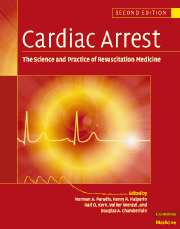Book contents
- Frontmatter
- Contents
- List of contributors
- Foreword
- Preface
- Part I Introduction
- Part II Basic science
- Part III The pathophysiology of global ischemia and reperfusion
- Part IV Therapy of sudden death
- Part V Postresuscitation disease and its care
- Part VI Special resuscitation circumstances
- 52 Prevention of sudden death in patients at risk: channelopathies and arrhythmic syndromes in the structurally normal heart
- 53 Pediatric cardiopulmonary resuscitation
- 54 Resuscitation in elder persons
- 55 Asphyxial cardiac arrest
- 56 Hemorrhagic shock and hypovolemic cardiac arrest
- 57 Cardiopulmonary resuscitation in hypothermic patients
- 58 Cardiac arrest due to poisoning
- 59 Cardiac arrest during anesthesia
- 60 Resuscitation of the pregnant patient suffering sudden cardiac death
- 61 Drowning
- 62 Anaphylactic shock
- 63 High altitude resuscitation
- 64 Electrical injuries
- 65 Rare syndromes, commotio cordis, sudden death in athletes
- Part VII Special issues in resuscitation
- Index
63 - High altitude resuscitation
from Part VI - Special resuscitation circumstances
Published online by Cambridge University Press: 06 January 2010
- Frontmatter
- Contents
- List of contributors
- Foreword
- Preface
- Part I Introduction
- Part II Basic science
- Part III The pathophysiology of global ischemia and reperfusion
- Part IV Therapy of sudden death
- Part V Postresuscitation disease and its care
- Part VI Special resuscitation circumstances
- 52 Prevention of sudden death in patients at risk: channelopathies and arrhythmic syndromes in the structurally normal heart
- 53 Pediatric cardiopulmonary resuscitation
- 54 Resuscitation in elder persons
- 55 Asphyxial cardiac arrest
- 56 Hemorrhagic shock and hypovolemic cardiac arrest
- 57 Cardiopulmonary resuscitation in hypothermic patients
- 58 Cardiac arrest due to poisoning
- 59 Cardiac arrest during anesthesia
- 60 Resuscitation of the pregnant patient suffering sudden cardiac death
- 61 Drowning
- 62 Anaphylactic shock
- 63 High altitude resuscitation
- 64 Electrical injuries
- 65 Rare syndromes, commotio cordis, sudden death in athletes
- Part VII Special issues in resuscitation
- Index
Summary
Cardiac arrest in remote areas such as in the wilderness and at high altitude cannot be compared directly with cardiac arrest in the urban setting, and both scenarios merit specific consideration. Given that mountains and, in particular, ski resorts have become increasingly popular with tourists, the occurrence of cardiac arrest in more remote places becomes an epidemiologic problem. Moreover, millions of people worldwide travel by plane, where they are exposed to a high altitude environment that may contribute to cardiocirculatory problems or even cardiac arrest. This chapter focuses on both of these specific settings and their relevant physiologic and epidemiologic characteristics.
Cardiac arrest resulting from high altitude on mountains
Worldwide, it is estimated that approximately 40 million individuals live above 8000 feet, and 25 million live above 10 000 feet. Both travelers who arrive abruptly into an hypoxic environment and residents who live year round at such altitudes have different risks for cardiac arrest. Mountain sports activities and tourism are attracting increasing numbers of participants each year. This, combined with the rapid ascent made possible by air transportation, results in increased members of unacclimatized individuals at risk for high-altitude illness. More than 1 million visitors travel annually to the remote high mountain ranges of Asia, Africa, and South America. Approximately 35 million visitors travel annually to high-altitude recreation areas in the western United States.
The clinical syndrome of high-altitude illness comprises several symptoms that may overlap and share a common pathophysiology.
- Type
- Chapter
- Information
- Cardiac ArrestThe Science and Practice of Resuscitation Medicine, pp. 1118 - 1135Publisher: Cambridge University PressPrint publication year: 2007



